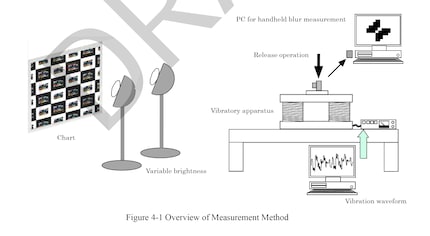
Background information
Lenses without autofocus: what can you use them for?
by David Lee

If you’re looking at the specs of a camera or lens with image stabilisation, you’re likely to see descriptions like «compensates up to five stops». But what does this figure actually mean? And how realistic is it?
Optical image stabilisers (IS) can be built into both lenses and cameras. Ideally, you’ll have both, with the two stabilisers working in tandem. This way, the camera’s IS compensates for movement that the lens’s IS doesn’t detect.
Manufacturers quantify the performance of their stabilisers with specs such as «compensates up to five stops». I want to find out exactly how they arrive at these figures – and how realistic they are in practice.
Stops are a measure of exposure. Increasing the exposure by one stop means doubling the exposure time, say from 1/60 of a second to 1/30 of a second. Increasing the exposure by five stops would mean doubling the exposure time five times. For instance, this would take you from 1/60 of a second of exposure to about half a second.
If you can expose for a maximum of 1/60 of a second without IS to get a sharp image, an image stabiliser will give you half a second.
The best stabilisation systems – a combination of lens and camera stabilisers – go up to eight stops. That’s four seconds of exposure time in our example.
A tremendous improvement. But do the numbers stack up in real life? Numerous tests later, I’m inclined to say «not really». But let’s take a closer look.
How are these figures actually calculated? There’s a standardised way of measuring an image stabiliser’s performance. The standard was created by the CIPA (Camera + Imaging Products Association), an organisation representing the Japanese camera industry. During the measurement process, a «vibratory apparatus» moves the camera and lens as the camera’s shooting a test image.

The vibration device performs precisely predefined movements at a frequency of 500 Hz, doing so consistently over a 32-second period. This is necessary so that the results of different cameras and lenses can be compared with each other. However, these regularly timed, mechanical movements differ from the movements of a real-life hand, which can be very abrupt and unpredictable. More importantly, hands don’t always move in the same way.
Here’s a CIPA-certified vibration machine in action.
That’s the theoretical side of things. Using the Canon EOS R7 with the RF-S 18-150 mm lens, I’ll demonstrate that it’s a different story in practice. According to Canon, the camera and lens combined deliver stabilisation of up to seven stops based on the CIPA method. That’s for a focal length of 150 millimetres.
First things first, I need to know how long I can expose without stabilisation. As a rule of thumb, you need to select at least the focal length as a fraction of a second. With this in mind, I take three photos at 1/160 of a second. One of them turns out blurry, while the other two are sharp. I took the photos standing up. Sitting with my elbows propped up, all three photos are in focus. At 1/80 of a second, all three are slightly out of focus. That means my general rule is about right. However, as you can see, it depends on your body position when taking the photo.
I then take three shots at each shutter speed, with stabilisation switched on. Again, I do all this from a standing position first before sitting down to take the next set of photos propped up on my elbows. At 1/10 of a second, all the images are sharp. At 1/5 of a second, i.e. 0.2 seconds, one of the photos taken from a standing position is blurry. Doubling the exposure time to 0.4 seconds, all photos taken from a standing position go blurry, with two out of three taken from a sitting position doing the same. At 0.8 seconds, one of each type of photo is in focus.
At this exposure time, the image stabilisation really does deliver its promised seven stops. However, it’s also possible you’ll blur the shot – even at faster shutter speeds.
It’s clear now what «up to seven stops» means. Under laboratory conditions, the system manages seven stops – no less. But in practice, this will rarely be the case. As my own example demonstrates, it’s possible, but by no means guaranteed.
Every camera and every lens is different. I might come less close to the CIPA figure when using other devices. Especially if the stabiliser’s meant to compensate for shots lasting several seconds, as manufacturers claim is the case for wide-angle lenses used with camera stabilisation. The Canon RF 15-35 mm supposedly compensates for seven stops in combination with a camera stabiliser. Starting at 1/15 of a second, this would give you eight seconds of exposure time – an utterly unrealistic figure. The viewfinder image stays black for these eight seconds, and I’ve no control over whether I’m keeping the crop more or less constant. As a result, the images are completely blurred, even with the best stabiliser.
Let’s take a look at the other end of the focal length spectrum, using the RF 800mm F11 super-telephoto lens as an example. According to the CIPA test, the lens’s image stabiliser compensates for four stops. The camera stabiliser, on the other hand, has no effect. In practice, the results are very inconsistent both with and without the image stabiliser. This is down to the fact that the tiniest of hand movements has a major impact when you’re using a super-telephoto lens. Depending on the movement of my hand, a 1/400 second shot can be sharp without IS enabled and blurred with the stabiliser on. But I’ve also taken photos at 1/80 of a second that turned out sharp. However, this is only achievable with a stabiliser.

With such major irregularities, you can’t rely on the image stabiliser to actually compensate for four stops. It occasionally works, but it’s dependent on luck. This tends not to affect me anyway. I use the 800 mm lens to photograph small birds. They’re so lively that I need to use very short exposures to get most of my photos to turn out in focus. With shutter speeds in the range of 1/1,000 of a second or even less, the image turns out sharp even without a stabiliser.
Now, that doesn’t mean using an IS for bird photography would be completely pointless. Quite the opposite, in fact. With the stabiliser switched off, the viewfinder image shakes so much I can barely keep the bird in the frame and in focus. However, the exact CIPA figure isn’t important in this scenario.
The CIPA figures are based on standardised lab tests. The goal of the data resulting from these tests is to be able to compare different image stabilisers. However, you can’t assume you’ll get the same figure in practice. Especially if you have nothing to lean on to keep your hands steady.
The CIPA figures aren’t entirely reflected in real-life use, particularly when it comes to very short and very long focal lengths. Using wide-angle lenses, exposure times of more than five stops lead to shutter speeds of several seconds, which is hardly possible when shooting freehand. As for super-telephoto lenses, the unpredictability of the photographer’s hand movements has a stark impact. With these lenses, however, a stabiliser is essential if you’re to get a steady viewfinder image. The exact CIPA figure is insignificant in this scenario.
My interest in IT and writing landed me in tech journalism early on (2000). I want to know how we can use technology without being used. Outside of the office, I’m a keen musician who makes up for lacking talent with excessive enthusiasm.
Interesting facts about products, behind-the-scenes looks at manufacturers and deep-dives on interesting people.
Show all